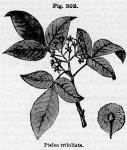
 Preparations: Extract of Ptelea
Preparations: Extract of Ptelea
Related entries: Oleoresina Pteleae.—Oleoresin of Ptelea
The bark of the root of Ptelea trifoliata, Linné.
Nat. Ord.—Rutaceae.
COMMON NAMES: Wafer ash, Shrubby trefoil, Hop tree, Swamp dogwood, Wingseed.
Botanical Source.—This plant is a shrub from 6 to 8 feet in height, leaves trifoliate, marked with pellucid dots; leaflets sessile, ovate, short, acuminate, downy beneath when young, crenulate, or obscurely toothed; lateral ones inequilateral, terminal ones cuneate at the base, 3 to 4 ½ inches long by 1 ¼ to 1 ¾ inches wide. The flowers are polygamous, greenish-white, nearly ½ inch in diameter, of a disagreeable odor, and borne in terminal corymbose cymes. Stamens mostly 4; style short. The fruit is a 2-celled samara, nearly 1 inch in diameter, winged all around, and nearly orbicular (G.—W.).
History and Description.—Wafer ash, or ptelea, is a shrub common to this country, growing more abundantly west of the Alleghanies, in shady, moist hedges, and edges of woods, and in rocky places; it flowers in June. The bark of the root is medicinal, and yields its properties to boiling water, but alcohol is its best solvent. It is when dried, of a light, brownish-yellow color externally, in cylindrical rolls or quills, 1 or 2 lines in thickness, and from 1 to several inches in length, irregularly wrinkled and furrowed externally, with broad, transverse lines or rings at short but irregular intervals, and is covered with a thin epidermis; internally it is yellowish-white, but becomes darker on exposure, and is wrinkled longitudinally. It is brittle, with an almost smooth, resinous fracture; granular under the microscope, resembling wax. It has a peculiar smell, somewhat similar to that of liquorice root, and a peculiar, bitter, resinous, pungent, acrid, and rather disagreeable taste, speedily and powerfully acting upon the mouth and fauces, and of persistent pungency, which is probably owing to its oleoresin. The leaves and fruit have also been used in medicine. A related species, Ptelea angustifolia, Bentham, is indigenous to Colorado.
Chemical Composition.—Mr. George M. Smyzer (Amer. Jour. Pharm., 1862, p. 200) found the bark of the root to contain gum, albumen, starch, volatile oil, of disagreeable taste and odor, fixed, oil, and probably potassium nitrate. No tannin was present. The active properties of the root he believes to be due both to the volatile oil and an acrid, soft resin, soluble in alcohol and ether; another brittle resin, soluble in ether, but insoluble in alcohol, is inert. The leaves yield to water a bitter infusion, resembling in taste that of hops, and containing tannic and gallic acids. The fruit is likewise bitter, and yields the same resins as the root. Justin Steer (ibid., 1867, p. 337) believes the bitterness of the root-bark and its virtues, as a tonic, to be due to berberine. More recently (Jahresb. der Pharm., 1896, p. 510), E. Schulze found the root of Ptelea trifoliata, to contain the base arginine (C6H14N4O2), a constituent of germinating Lupinus luteus, and other plants, and one of the decomposition products of horn, obtained when treating it with hydrochloric acid and stannous chloride (S. G. Hedin, Chem. Centralblatt, Vol. II, 1894, p. 993; and Vol. I, 1896, p. 118). It is characterized by a dark-blue crystallizable compound with copper nitrate [C6H14N4O2]2.Cu[NO3]2.3H2O).
Action, Medical Uses, and Dosage.—Ptelea is tonic, and surpassed in this line only by hydrastis. Used after intermittent fevers, remittent fevers, and all cases of debility where tonics are indicated. Said also to be anthelmintic. Equal parts of ptelea and Euonymus atropurpureus, have been found very useful in pulmonary affections. A tincture of ptelea, made in whiskey, is reputed to have cured several cases of asthma, and is said to cause, in many instances where it has been used, a troublesome external erysipelatous inflammation, either general or local, but which, if the use of the tincture be persisted in, finally disappears, and the patient becomes, at the same time, permanently cured of the disease for which he was treated. This would certainly indicate other valuable properties in this plant, than those with which we are acquainted, which deserve a further and thorough investigation. Prof. I. G. Jones stated that this bark is a pure, unirritating tonic, having rather a soothing influence when applied to irritated mucous membranes. He has employed it advantageously in convalescence after fevers, and in debility connected with gastro-enteric irritation. It promotes the appetite, enables the stomach to endure suitable nourishment, favors the early reestablishment of digestion, and will be tolerated by the stomach when other tonics are rejected. He employed it in cold infusion, of which ½ fluid ounce may be given every 2, 3, or 4 hours, according to circumstances. It is also said to cure intermittent fever, and is considered by some to be equal to quinine. It may be used in powder, tincture, or extract. Dose of the powder, 10 to 30 grains, 3 or 4 times a day; of the tincture, 1 or 2 fluid drachms; of the extract, 5 to 10 grains; specific ptelea, 1 to 20 drops.
Specific Indications and Uses.—Asthmatic breathing; chronic diseases, with sense of constriction in the chest, and short breathing.

